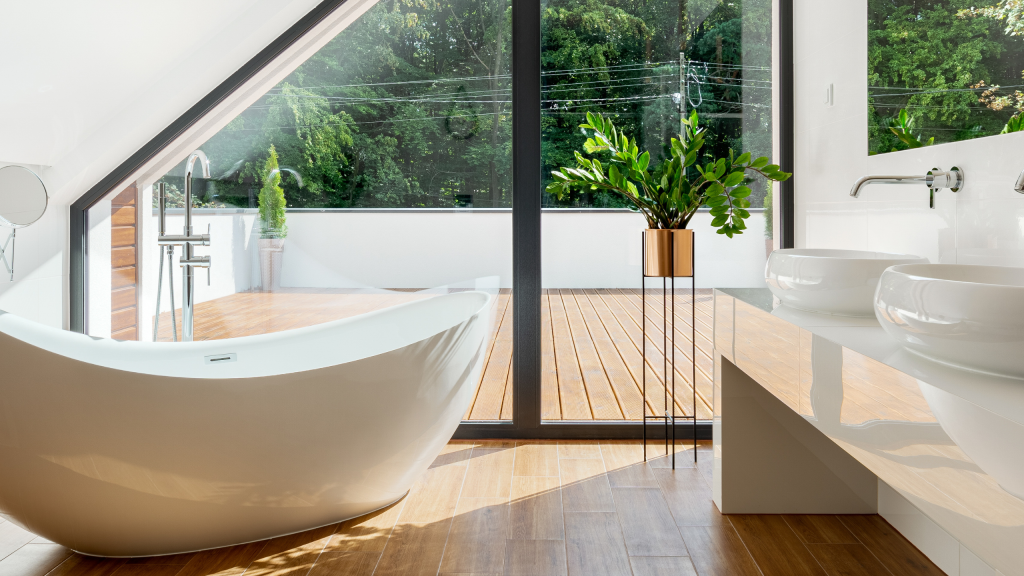Bathroom renovation is a multifaceted endeavor where “reglazing” and “refinishing” frequently arise, albeit with their interchangeability. Yet, beneath this apparent similarity lies a significant distinction. Reglazing and refinishing constitute discrete processes, each bearing its own set of procedures and outcomes. Both methods share the goal of breathing new life into your bathtub, yet comprehending their nuances is pivotal in steering your renovation toward the envisioned outcome. Ready to give your bathtub a makeover? Haverford Bathtub Refinishing is the answer! Contact us to schedule your reglazing appointment today!
Distinguishing Reglazing from Refinishing
Understanding the difference between reglazing and refinishing is important for bathroom renovations. Reglazing, also known as resurfacing or re-enameling, involves carefully putting a new layer of glaze on the bathtub’s surface. This needs thorough preparation to ensure the new glaze sticks well, resulting in a shiny finish that makes the bathroom look new. It’s like giving the bathtub a makeover, making it look better, and creating a fresh feeling in the bathroom.
Refinishing, on the other hand, fixes any damage to the surface, like chips or cracks, before adding a final coat. This process ensures that the bathtub not only looks good but also works well.
Effective Cleaning Techniques for Bathtub Surfaces
- Baking Soda and Vinegar: This dynamic duo forms a powerful natural abrasive when mixed together. The baking soda acts as a gentle scouring agent, while the acidic nature of vinegar helps dissolve tough stains and soap scum. When combined, they provide a powerful cleaning agent that efficiently tackles grime without the need for dangerous substances, guaranteeing that it is secure for the environment and regular use.
- Commercial Cleaners: Specially formulated for the specific demands of bathtub cleaning, commercial cleaners offer a convenient solution for removing stubborn grime and mineral deposits. These products often contain potent ingredients that work to dissolve dirt and restore shine with minimal effort, making them ideal for busy households or deep cleaning sessions.
- Lemon Juice: With its natural acidity, lemon juice is a formidable weapon against grease and soap residue buildup on bathtub surfaces. Beyond its cleaning power, the citrus scent leaves a refreshing aroma, enhancing the bathing experience while effectively cutting through grime.
- Steam Cleaning: Harnessing the power of high-pressure steam, steam cleaners penetrate deep into crevices and pores, loosening dirt and grime without chemical cleaners. This method is particularly useful for reaching tight spaces and corners, providing a thorough cleaning experience while eliminating the risk of chemical residue.
- Magic Erasers: These innovative cleaning pads, made from melamine foam, work wonders on tough stains and scuff marks. Their unique texture effectively lifts dirt and grime from bathtub surfaces with minimal effort, making them an excellent choice for quick touch-ups and spot cleaning.
- Hydrogen Peroxide: Renowned for its disinfecting and whitening properties, hydrogen peroxide offers a gentle yet effective cleaning solution for bathtub surfaces. Its bubbling action helps lift dirt and stains while brightening the surface, leaving a fresh and hygienic finish behind.
- Microfiber Cloths: These soft and absorbent cloths are perfect for wiping down bathtub surfaces after cleaning. Their fine fibers trap dirt and residue, ensuring a streak-free shine without the risk of scratching or damaging the finish.
- Dish Soap: Mild yet effective, dish soap is a versatile cleaner that breaks down grease and grime without compromising the bathtub’s finish. It is appropriate for frequent usage due to its mild composition providing a reliable solution for everyday cleaning tasks.
- DIY Cleaning Solutions: Crafting homemade cleaners using ingredients like dish soap and vinegar offers a customizable and budget-friendly alternative to commercial products. These DIY solutions can be tailored to suit specific cleaning needs and are often gentler on the environment, making them a sustainable choice for eco-conscious households.
- Regular Maintenance: A consistent cleaning routine is essential for preventing dirt and grime buildup on bathtub surfaces. By incorporating regular maintenance into your cleaning regimen, You can make sure your bathtub stays spotless, hygienic, and inviting for every use, prolonging its lifespan and maintaining its pristine appearance over time.
Preparation: The Key to Successful Reglazing
Before reglazing, preparing the bathtub is super important. This means getting rid of all the soap scum, dirt, and any leftover stuff on the surface. It’s like giving the bathtub a really good cleaning before putting on the new glaze. Doing this well is crucial because it helps the new glaze stick properly. If you skip this step, the glaze might not stay on well and could start coming off sooner than expected. So, by ensuring the bathtub is super clean before reglazing, you’re setting it up to look good and last longer.
In Conclusion
Comprehending the disparities between reglazing and refinishing, alongside implementing effective cleaning techniques, serves as the bedrock for a triumphant bathroom renovation endeavor. Thorough preparation emerges as the linchpin, ensuring a seamless transition and impeccable results. By meticulously removing grime and residues, the stage is set for flawless execution, promising longevity and enduring elegance for your revitalized bathtub. This commitment to detail enhances the aesthetic appeal and safeguards against premature wear, ensuring that your investment in a rejuvenated bathing space stands the test of time, radiating sophistication and charm for years to come.

